Kicker Solo-Baric DS12L7 Handleiding
Bekijk gratis de handleiding van Kicker Solo-Baric DS12L7 (4 pagina’s), behorend tot de categorie Subwoofer. Deze gids werd als nuttig beoordeeld door 52 mensen en kreeg gemiddeld 4.3 sterren uit 26.5 reviews. Heb je een vraag over Kicker Solo-Baric DS12L7 of wil je andere gebruikers van dit product iets vragen? Stel een vraag
Pagina 1/4

Congratulations. You have just purchased one of the car audio world’s pre-
mier subwoofers. KICKER® Solo-Baric™ D-Series subwoofer’s unique design
delivers all the performance advantages of isobaric pair enclosure technolo-
gy in a single driver. The result is truly incredible levels of bass using enclo-
sures only half the size of traditional boxes.
SOLO-BARIC™
D-SERIES SUBWOOFERS
SOLO-BARIC FEATURES
Every element of the Solo-Baric’s design is optimized for accurate reproduction of bass
and sub-bass frequencies. The Solo-Baric has one of the most massive moving structures
in speaker design history, yet it still has the ultra-low distortion and lightning-fast transient
response essential for critical bass reproduction. New to the D-Series is the Solo-Baric
hemispherical cone, KICKER's most distortion-resistant cone technology to date. Voice coils
are made from ribbon copper wire, wound in multiple layers on black Kapton® formers for
superior heat-dissipation. The rest of the motor structure incorporates design/perform-
ance features that make Solo-Barics world-famous for performance and
durability...UniPlate™ construction, one-piece extended pole, deep-bump backplate,
stitched surround, heavy-duty terminals, high-power PVC-sleeved speaker leads, and more.
Additional Solo-Baric Performance Enhancements:
• Cast aluminum basket for superior support and great looks
• Flat progressive-roll spider for superior control and linearity
• Perimeter Venting to release pressures between spider and top plate
• Heavy-duty nickel-plated terminals for positive connections
POWER HANDLING
Power handling ratings on Solo-Baric subwoofers reflect the largest power amplifiers
suitable for use on each model. We feel this rating is more useful to you than misleading
“music power”, “continuous”, or other ratings often used.
The power ratings refer to the speaker’s ability to dissipate heat from the voice coil,
not the mechanical limits of cone excursion. Because the enclosure largely controls cone
travel, we have provided enclosure designs that will best prevent problems due to cone
over-excursion.
The minimum power rating suggests the least amount of RMS power per driver we
recommend when designing a system using Solo-Barics. Too little power can result in low
output and distorted sound. We recommend using as much power as possible, up to the
maximum power ratings listed in the Specifications section.

A Note on Power Handling Capability:
The S15d and S8d will handle full rated power in the recommended enclosure size.
However, the S12d and S10d have specific excursion limited (not thermal limited) power
ratings in their stock box sizes. For these models to handle their rated power they must be
used in smaller boxes.
The S10d will easily handle up to 350 watts in the .66 cubic enclosure; if more power (up
to 450 watts) is available, the box size should be reduced to .60 cubic feet.
The S12d will handle up to 425 watts in the .88 cubic enclosure; if more power (up to 600
watts) is available, the box size should be reduced to .66 cubic feet.
BUILDING YOUR ENCLOSURE
Your enclosure should be made of 3/4" wood, minimum. Avoid low density material such
as common particle board and low grades of plywood. The recommended materials are
MDF (medium density fiberboard), high density particle board or high quality void free 7 to
13 ply plywood such as marine plywood. Because of the extreme pressures which can
occur in the small enclosure your driver requires, use of material thinner than 3/4” may
result in panel vibration and should be avoided.
When assembling the box, include glue blocks to strengthen corners and add
cross-braces if you detect panel vibrations. Use a good grade of wood glue (such as
Elmer’s Professional or Titebond) on all joints. Do not use silicone, hot glue or caulk in
place of glue. When the glue has set, seal all the inside joints with a liberal application of
silicone sealer. This is important to ensure an airtight seal.
All the recommended enclosure specs require a 50% fill of polyester fiber. Commonly
called fiberfill, it is normally used as pillow stuffing.
The use of terminal cups is the preferred means for getting wires to the woofer. If cups
are not available drill a hole slightly larger than the wire used and carefully seal around the
wire with silicone sealer. This is also very important to maintain a perfect seal in the box.
Be sure to observe polarity when wiring up any speakers. Incorrect polarity will cause a
loss of sound quality and in the case of woofers it can decrease output dramatically.
If the woofer mounting hole is not cut exactly to specifications there is a good chance
that air can leak out through the screw holes. To remedy this problem you can use a
non-hardening sealer such as rope caulk or plumber’s putty. Do not use silicone products
to seal the woofer to the enclosure as this will void your warranty.
NOTE: DO NOT USE SOLO-BARIC DRIVERS IN THE FOLLOWING ENCLOSURE DESIGNS:
• Larger than recommended sealed enclosures
• Any vented or ported enclosure
• Free air or infinite baffle mounting
• “7th order” double-vented bandpass enclosures
• Passive radiator designs
Use of the Solo-Baric in enclosures with improper sealed volume can result in driver failure
that may not be covered under warranty.

RECOMMENDED ENCLOSURES
Solo-Baric drivers are designed to be used in small cabinets and behave very much as
an isobaric pair of KICKER Competition™ drivers. They are optimized for excellent
performance in a specific range of sealed or single reflex bandpass enclosures. Use of
these drivers in non-recommended enclosures can result in driver damage and loss of
warranty on the driver.
The following shows suitable enclosures for Solo-Baric subwoofers. We highly
recommend that custom enclosures varying from the dimensions…and especially bandpass
enclosures…be designed and built by an Authorized KICKER Solo-Baric Dealer.
PANEL DIMENSIONS
Model Panel A (in.) Panel B (in.) Panel C (in.) Enclosure Volume (cu. ft.)
S15d 16-1/2 x 16-1/2 16-1/2 x 11-1/2 15 x 11-1/2 1.5
S12d 13 x13 13 x 11-1/2 11-1/2 x 11-1/2 .88
S10d 12 x12 12 x 10-1/2 10-1/2 x 10-1/2 .66
S8d 10 x10 10 x 8 8 x 8-1/2 .33
Note: Panels should be 3/4” MDF.
SOLO-BARIC D-SERIES SPECIFICATIONS
Model Impedance Max. Amp Sensitivity Frequency Mounting Mounting Hole Recommended
(ohms) Power (dB 1w/1m)‡ Response Depth Diameter Sealed Enclosure
(watts)† (in., mm) (in., mm) Volume
S15d 2, 4, 8 750 89.3 18-100 7, 178 14-1/16, 357 1.5
S12d 2, 4, 8 600 87.7 20-100 5-5/8, 143 11-1/8, 283 .88
S10d 2, 4, 8 450 87.6 24-100 4-7/8, 124 9-3/8, 234 .66
S8d 2, 4, 8 300 86.2 28-100 3-7/8, 99 7-5/16, 186 .33
† Assumes typical music program with minimal amplifier clipping
‡ Methods used for deriving sensitivity vary widely; therefore, caution should be used
when comparing the sensitivity ratings of various speakers. Solo-Baric ratings are based
on a procedure called Theoretical Piston Efficiency, a measurement which reflects the per-
formance of the speaker in real-world applications.
If you have more questions about the installation of your new KICKER component,
see the Authorized KICKER Dealer where you purchased your component. You may
also call our Technical Services phone line at 405-624-8583 for technical assistance.
Product specificaties
| Merk: | Kicker |
| Categorie: | Subwoofer |
| Model: | Solo-Baric DS12L7 |
Heb je hulp nodig?
Als je hulp nodig hebt met Kicker Solo-Baric DS12L7 stel dan hieronder een vraag en andere gebruikers zullen je antwoorden
Handleiding Subwoofer Kicker
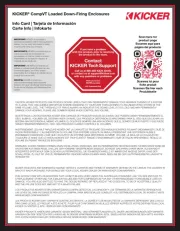
5 Juli 2025
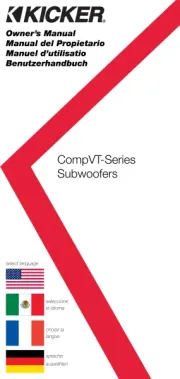
4 Juli 2025
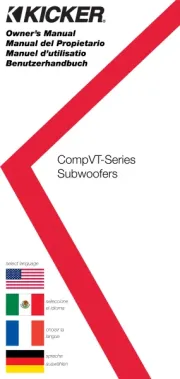
4 Juli 2025
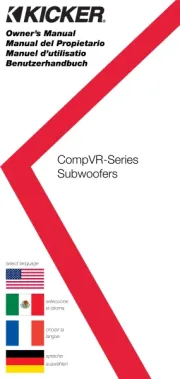
4 Juli 2025
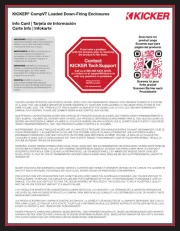
4 Juli 2025
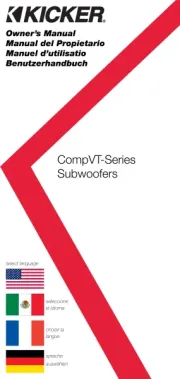
1 Juli 2025
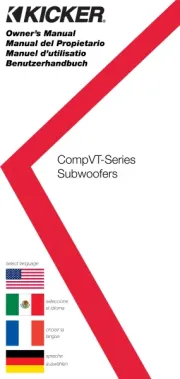
30 Juni 2025
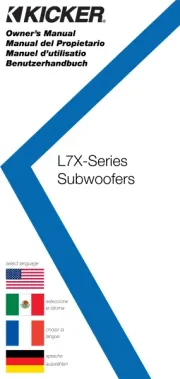
2 Mei 2025
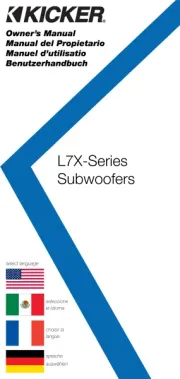
2 Mei 2025
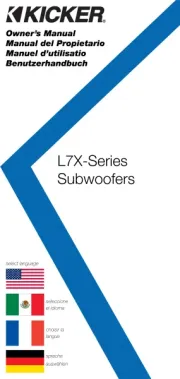
2 Mei 2025
Handleiding Subwoofer
- Dynaudio
- Mac Audio
- Dali
- Jamo
- Eminence
- PreSonus
- Q Acoustics
- BMB
- Argon
- Mirage
- KRK
- OSD Audio
- Nxg
- AV:link
- Helix
Nieuwste handleidingen voor Subwoofer
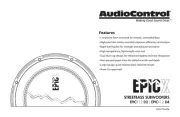
29 Juli 2025
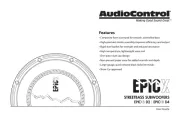
29 Juli 2025
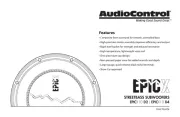
29 Juli 2025
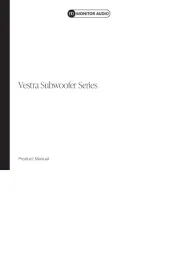
24 Juli 2025
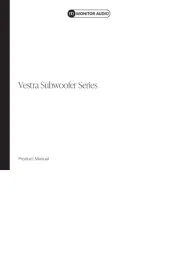
24 Juli 2025

21 Juli 2025

21 Juli 2025
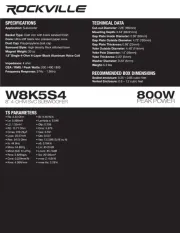
15 Juli 2025
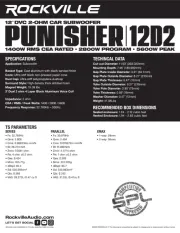
15 Juli 2025
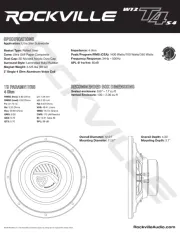
15 Juli 2025